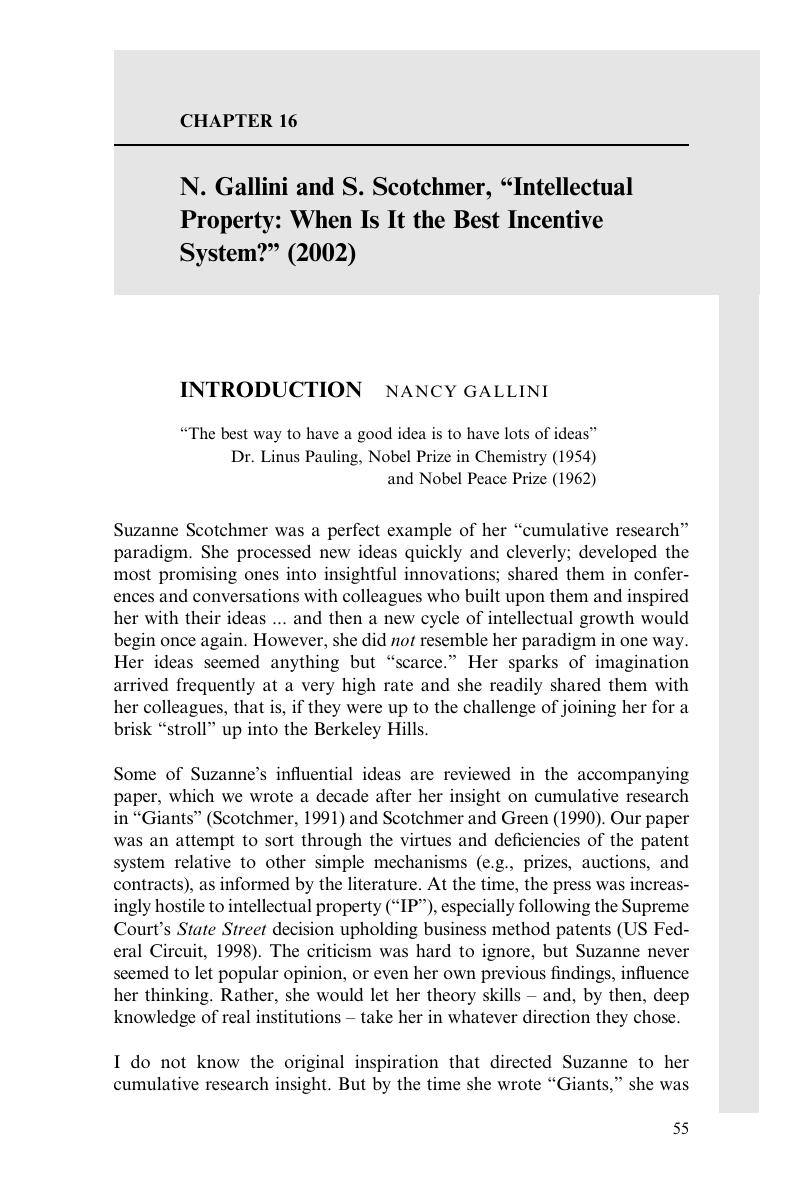Book contents
- On the Shoulders of Giants
- Econometric Society Monographs
- On the Shoulders of Giants
- Copyright page
- Dedication
- Contents
- Contributors
- Preface
- Acknowledgments
- Chapter 1 Introduction
- Part I Threads in the Tapestry
- Part II Innovation Theory (I): Cumulative Innovation
- Chapter 14 The Giant’s Shoulders
- Chapter 15 Reimagining Innovation Theory: Suzanne Scotchmer and the Ideas Model
- Chapter 16 N. Gallini and S. Scotchmer, “Intellectual Property: When Is It the Best Incentive System?” (2002)
- Chapter 17 Suzanne Scotchmer, “Standing on the Shoulders of Giants: Cumulative Research and the Patent Law” (1991) and Jerry Green and Suzanne Scotchmer, “On the Division of Profit in Sequential Innovation” (1995)
- Chapter 18 Ted O’Donoghue, Suzanne Scotchmer, and Jacques Thisse, “Patent Breadth, Patent Life, and the Pace of Technological Progress” (1998)
- Part III Innovation Theory (II): Law and Economics
- Part IV Club Theory
- Part V Evolutionary Game Theory
- Part VI Public Policy
- Part VII Living Legacy
- Part VIII Epilog
- Bibliography
- Index
- References
Chapter 16 - N. Gallini and S. Scotchmer, “Intellectual Property: When Is It the Best Incentive System?” (2002)
from Part II - Innovation Theory (I): Cumulative Innovation
Published online by Cambridge University Press: 12 October 2017
- On the Shoulders of Giants
- Econometric Society Monographs
- On the Shoulders of Giants
- Copyright page
- Dedication
- Contents
- Contributors
- Preface
- Acknowledgments
- Chapter 1 Introduction
- Part I Threads in the Tapestry
- Part II Innovation Theory (I): Cumulative Innovation
- Chapter 14 The Giant’s Shoulders
- Chapter 15 Reimagining Innovation Theory: Suzanne Scotchmer and the Ideas Model
- Chapter 16 N. Gallini and S. Scotchmer, “Intellectual Property: When Is It the Best Incentive System?” (2002)
- Chapter 17 Suzanne Scotchmer, “Standing on the Shoulders of Giants: Cumulative Research and the Patent Law” (1991) and Jerry Green and Suzanne Scotchmer, “On the Division of Profit in Sequential Innovation” (1995)
- Chapter 18 Ted O’Donoghue, Suzanne Scotchmer, and Jacques Thisse, “Patent Breadth, Patent Life, and the Pace of Technological Progress” (1998)
- Part III Innovation Theory (II): Law and Economics
- Part IV Club Theory
- Part V Evolutionary Game Theory
- Part VI Public Policy
- Part VII Living Legacy
- Part VIII Epilog
- Bibliography
- Index
- References
Summary

- Type
- Chapter
- Information
- On the Shoulders of GiantsColleagues Remember Suzanne Scotchmer's Contributions to Economics, pp. 50 - 54Publisher: Cambridge University PressPrint publication year: 2017
References
- 1
- Cited by



